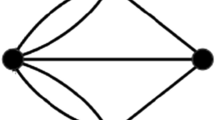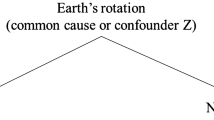Abstract
In the causal inference framework of Spirtes, Glymour, and Scheines (SGS), inferences about causal relationships are made from samples from probability distributions and a number of assumptions relating causal relations to probability distributions. The most controversial of these assumptions is the Causal Faithfulness Assumption, which roughly states that if a conditional independence statement is true of a probability distribution generated by a causal structure, it is entailed by the causal structure and not just for particular parameter values. In this paper we show that the addition of the Causal Faithfulness Assumption plays three quite different roles in the SGS framework: (i) it reduces the degree of underdetermination of causal structure by probability distribution; (ii) computationally, it justifies reliable (constraint-based) causal inference algorithms that would otherwise have to be slower in order to be reliable; and (iii) statistically, it implies that those algorithms reliably obtain the correct answer at smaller sample sizes than would otherwise be the case. We also consider a number of variations on the Causal Faithfulness Assumption, and show how they affect each of these three roles.




Similar content being viewed by others
Notes
The stipulation that a node counts as its own ancestor and descendant has some technical convenience.
For three disjoint sets of random variables \(\mathbf{X},\mathbf{Y}, \mathbf{Z}\), we write
 for the statement that X and Y are conditionally independent given Z. The statement is satisfied by a probability distribution \(P\) or true according to \(P\) iff \(P(\mathbf{X }= x \vert \mathbf{Y} = y, \mathbf{Z} = z)=P(\mathbf{X }= x | \mathbf{Z} = z)\) for every (vector) value \(x\) of \(\mathbf{X}, y\) of \(\mathbf{Y}, z\) of Z s.t. \(P(\mathbf{Y} = y, \mathbf{Z} = z) > 0\). When Y is an empty set,
for the statement that X and Y are conditionally independent given Z. The statement is satisfied by a probability distribution \(P\) or true according to \(P\) iff \(P(\mathbf{X }= x \vert \mathbf{Y} = y, \mathbf{Z} = z)=P(\mathbf{X }= x | \mathbf{Z} = z)\) for every (vector) value \(x\) of \(\mathbf{X}, y\) of \(\mathbf{Y}, z\) of Z s.t. \(P(\mathbf{Y} = y, \mathbf{Z} = z) > 0\). When Y is an empty set,  is trivially satisfied by all probability distributions. When Z is empty, we often just write
is trivially satisfied by all probability distributions. When Z is empty, we often just write  , short for \( {\varnothing }\). For singleton sets, we will abuse notation and omit the curly brackets. See e.g., Dawid (1979) and Pearl (1988) for detailed discussions of conditional independence.
, short for \( {\varnothing }\). For singleton sets, we will abuse notation and omit the curly brackets. See e.g., Dawid (1979) and Pearl (1988) for detailed discussions of conditional independence.All the entailed conditional independence statements can be easily read off a given causal structure by a graph criterion called d-separation (Pearl 1988).
This will generally be the case if V does not leave out any common causes of two variables in V, there is no selection bias in the sampling, and the true causal structure is either acyclic or linear.
If \(P\) does not satisfy any nontrivial conditional independence statement, then M(\(P) =\) M-F(\(P)\) is the set of complete causal structures.
Another consequence of the CFA, named Orientation-Faithfulness, is often discussed alongside Adjacency-Faithfulness. The Adjacency-Faithfulness assumption, as we will show, can reduce underdetermination as much as the CFA does without Orientation-Faithfulness, but the Orientation-Faithfulness assumption cannot do without Adjacency-Faithfulness.
Interested readers can check that given the CMA and the Adjacency-Faithfulness assumption, the causal structures that are compatible with the said distribution remain the three structures in Fig. 2.
Basically the reason is that no DAG with just three adjacencies (one between \(V\) \(_{1}\) and \(V_{2}\), one between \(V_{2}\) and \(V_{3}\), and one between \(V_{3}\) and \(V_{4})\) is Markov to the said distribution. Adding any other adjacency yields a DAG to which the said distribution is not Adjacency-Faithful.
Basically the reason is that every DAG to which the said distribution is Markov and Triangle-Faithful must have at least the three arrows \(V_{1} \rightarrow V_{3}, V_{2 } \rightarrow V_{3}\), and \(V_{3} \rightarrow V_{4}\) (cf. the VCSGS algorithm we will describe in the next section). Since it is not true that
 , an edge between \(V_{1}\) and \(V_{2}\) has to be added in order to be Markov to the distribution. Then the triangle \({<}V_{1}, V_{3}, V_{2}{>}\) would fail the Triangle-Faithfulness.
, an edge between \(V_{1}\) and \(V_{2}\) has to be added in order to be Markov to the distribution. Then the triangle \({<}V_{1}, V_{3}, V_{2}{>}\) would fail the Triangle-Faithfulness.It is a sub-model in that it entails a superset of conditional independence constraints and so is compatible with a subset of probability distributions.
One way to see this is that the causal Minimality assumption, by itself, cannot rule out any causal order: for every ordering of the variables, there is a minimal DAG that satisfies the CMA.
We do know that it is not true that whenever \(\mathbf{M}\hbox {-}\mathbf{M}\mathbf{}\hbox {-}\mathbf{TF}(P) \ne \varnothing , \mathbf{M}\hbox {-}\mathbf{PM}(P) = \mathbf{M}\hbox {-}\mathbf{M}\hbox {-}\mathbf{TF}(P)\). That is, there are cases in which the conjunction of the causal Minimality assumption and the Triangle-Faithfulness assumption reduces underdetermination to a greater extent than the P-Minimality assumption does. Raskutti and Uhler (2014) presented such an example in the proof of their Theorem 2.8. (b).
For the sample version of the PC algorithm, this bound holds with high probability.
As we stress at the end, our discussion here is limited to the known constraint-based algorithms. We do not know whether similar points can be made for the score-based or the Bayesian approach, or even how weakening of the CFA bears on that approach. We thank an anonymous referee for raising this issue, and hope to explore it in future work.
References
Andersen, H. (2013). When to expect violations of causal faithfulness and why it matters. Philosophy of Science Supplement, 5, 672–683.
Cartwright, N. (2001). What is wrong with Bayes nets? The Monist, 84, 242–264.
Dawid, P. (1979). Conditional independence in statistical theory. Journal of the Royal Statistical Society, Series B, 41, 1–31.
Hausman, D., & Woodward, J. (1999). Independence, invariance and the causal Markov condition. British Journal for the Philosophy of Science, 50, 521–583.
Hitchcock, C. (2010). Probabilistic causation. In E. Zalta ( Ed.), Stanford encyclopedia of philosophy.http://plato.stanford.edu/entries/causation-probabilistic/.
Hoover, K. D. (2001). Causality in macroeconomics. Cambridge: Cambridge University Press.
Hoyer, P., Janzing, D., Mooij, J., Peters, J., Scholkopf, B. (2008). Nonlinear causal discovery with additive noise models. In Advances in neural information processing systems 21 (NIPS 2008), pp. 689–696.
Kalisch, M., & Bühlmann, P. (2007). Estimating high-dimensional directed acyclic graphs with the PC-algorithm. Journal of Machine Learning Research, 8, 613–636.
Loh, P., & Bühlmann, P. (2013). High-dimensional learning of linear causal networks via inverse covariance estimation. arXiv:1311.3492v1 [stat.ML].
Pearl, J. (1988). Probabilistic reasoning in intelligence systems. San Mateo, CA: Morgan Kaufmann.
Pearl, J. (2009). Causality: Models, reasoning, and inference (2nd ed.). Cambridge: Cambridge University Press.
Peters, J., Janzing, D., & Scholkopf, B. (2011). Causal inference on discrete data using additive noise models. IEEE Transactions on Pattern Analysis and Machine Intelligence, 33(12), 2436–2450.
Ramsey, J., Spirtes, P., & Zhang, J. (2006). Adjacency-faithfulness and conservative causal inference. Proceedings of 22nd conference on uncertainty in artificial intelligence (UAI-06), pp. 401–408.
Raskutti, G., & Uhler, C. (2014). Learning directed acyclic graphs based on sparsest permutations. arXiv:1307.0366v3 [math.ST].
Shimizu, S., Hoyer, P., Hyvärinen, A., & Kerminen, A. (2006). A linear non-Gaussian acyclic model for causal discovery. Journal of Machine Learning Research, 7, 2003–2030.
Spirtes, P., Glymour, C., & Scheines, R. (2000). Causation, prediction, and search (2nd ed.). Cambridge, MA: MIT Press.
Spirtes, P., & Zhang, J. (2014). A uniformly consistent estimator of causal effects under the k-triangle-faithfulness assumption. Statistical Science, 29, 662–678.
Steel, D. (2006). Homogeneity, selection, and the faithfulness condition. Minds and Machines, 16, 303–317.
Woodward, J. (1998). Causal independence and faithfulness. Multivariate Behavioral Research, 33, 129–148.
Zhang, J., & Spirtes, P. (2008). Detection of unfaithfulness and robust causal inference’. Minds and Machines, 18(2), 239–271.
Zhang, J. (2013). A comparison of three Occam’s Razors for Markovian causal models. British Journal for the Philosophy of Science, 64(2), 423–448.
Zhang, K., Peters, J., Janzing, D., & Schölkopf, B. (2011). Kernel-based conditional Independence test and application in causal discovery. Proceedings of the 27th conference on uncertainty in artificial intelligence (UAI-11), pp. 804–813.
Acknowledgments
We thank two referees for helpful comments. The research of J. Zhang was supported in part by the Research Grants Council of Hong Kong under the General Research Fund LU342213.
Author information
Authors and Affiliations
Corresponding author
Rights and permissions
About this article
Cite this article
Zhang, J., Spirtes, P. The three faces of faithfulness. Synthese 193, 1011–1027 (2016). https://doi.org/10.1007/s11229-015-0673-9
Received:
Accepted:
Published:
Issue Date:
DOI: https://doi.org/10.1007/s11229-015-0673-9





 for the statement that X and Y are conditionally independent given Z. The statement is satisfied by a probability distribution
for the statement that X and Y are conditionally independent given Z. The statement is satisfied by a probability distribution  is trivially satisfied by all probability distributions. When Z is empty, we often just write
is trivially satisfied by all probability distributions. When Z is empty, we often just write  , short for
, short for  , an edge between
, an edge between